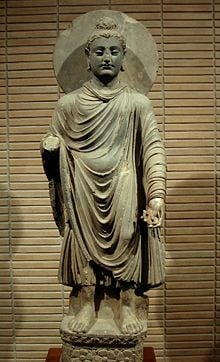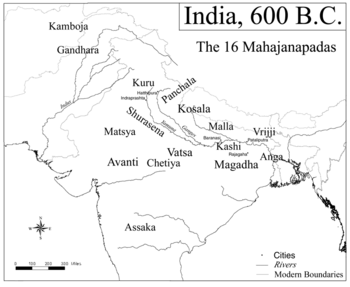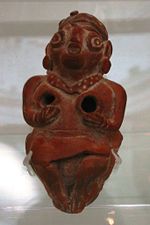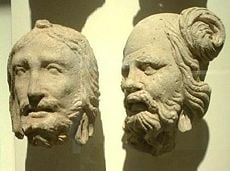Gandhara

Gandhāra is the name of an ancient, extinct kingdom once located in north-western India in what is now Pakistan and eastern Afghanistan. Found mainly in the valley of Peshawar, the Potohar plateau and on the Kabul River, its main cities were Purushapura (modern Peshawar), and Takshashila (Taxila).
The Kingdom of Gandhara lasted from around the sixth century B.C.E. to the eleventh century C.E. It attained its height from the first century to the fifth century, under the Buddhist Kushan Kings. After it was conquered by Mahmud of Ghazni in 1021 C.E., the name Gandhara disappeared. During the Muslim period the area was administered from Lahore or from Kabul.
The Kingdom of Gandhara was located at the cross-roads of cultural exchange and thus became a laboratory for religious syncretism and cross-cultural fermentation. Following Alexander the Great's invasion of north-western India, Gandhara became renowned for its fusion of Greek and Buddhist culture, which was evident in its treasures of Greco-Buddhist art including the famous Bamyan Buddhas. The Kingdom represents one of the highlights of cross-cultural syncretism between East and West. Additionally, the Gandharan city of Taxila was an important Hindu[1] and Buddhist center of learning from the fifth century B.C.E.[2] to the second century, one of the greatest monastic-universities of the ancient world.
The Kingdom of Gandhara exemplifies one of many historical civilizations in which multi-religious influences have been pivotal in creating flourishing but reconciling cultures. These historical times of religious harmony provided their citizens and the world with a positive environment in which art, literature, science and mutual understanding could blossom and flourish. It is known from such historical examples that periods of religious harmony have always been times of great learning and progress.
Geographical location
The boundaries of Gandhara varied throughout history. Sometimes the Peshawar valley and Taxila were collectively referred to as Gandhara and sometimes the Swat valley (Sanskrit: Suvāstu) was also included. The heart of Gandhara, however, was always the Peshawar valley. The kingdom was ruled from capitals at Pushkalavati (Charsadda), Taxila, Purushapura (Peshawar) and in its final days from Udabhandapura (Hund) on the Indus.
Since the Vedic times, the Gandhāri people settled on the banks of Kabul River (river Kubhā or Kabol) up to its mouth into the Indus. Later Gandhāra included parts of north-west Punjab of India, and benefited from the northern trunk road, which facilitated international commercial activities. Gandhara was an important channel of communication with ancient Iran and Central Asia.
The Gandhara kingdom sometimes also included Kashmir. Hecataeus of Miletus (549-468 C.E.) refers to Kaspapyros (sometimes interpreted as referring to Kashmira) as a Gandaric city. According to Gandhara Jataka (Jataka No 406), at one time, Gandhara formed a part of the kingdom of Kashmir. The Jataka also gives another name Chandahara for Gandhara. Buddhist texts like Anguttara Nikaya refer to sixteen great countries (Mahajanapadas) which flourished in the Indian sub-continent during Buddha's time; only two of them, the Gandhara and the Kamboja were located in the Uttarapatha or the north-western division.
The primary cities of Gandhara were Purushapura (now Peshawar), Takshashila (or Taxila) and Pushkalavati. The latter remained the capital of Gandhara from the sixth century B.C.E. to the second century C.E., when the capital was moved to Peshawar. An important Buddhist shrine helped to make the city a center of pilgrimage until the seventh century. Pushkalavati in the Peshawar Valley is situated at the confluence of the Swat and Kabul rivers, where three different branches of the River Kabul meet.
History
Prehistoric period
Evidence of Stone Age human inhabitants of Gandhara, including stone tools and burnt bones, was discovered at Sanghao near Mardan in area caves. The artifacts are approximately 15,000 years old.
The region shows an influx of southern Central Asian culture in the Bronze Age with the Gandhara grave culture showing a continuum between the early neolithic culture with close ties and relations with the Bactria-Margiana Archaeological Complex. This culture survived till 600 B.C.E. Its evidence has been discovered in the Hilly regions of Swat and Dir, and even at Taxila.
The name of the Gandhāris is attested in the Rigveda (RV 1.120.1) and in ancient inscriptions dating back to Achaemenid Persia. The Behistun inscription listing the 23 territories of King Darius I (519 B.C.E.) includes Gandāra along with Bactria and Thatagush. In the book "Histories" by Heroditus, Gandhara is named as a source of tax collections for King Darius. The Gandhāris, along with the Balhika (Bactrians), Mūjavants, Angas, and the Magadhas, are also mentioned in the Atharvaveda (AV 5.22.14), as distant people. Gandharas are included in the Uttarapatha division of Puranic and Buddhistic traditions. The Aitareya Brahmana refers to king Naganajit of Gandhara who was contemporary of Janaka, king of Videha.
Gandharas and their king figure prominently as strong allies of the Kurus against the Pandavas in the Mahabharata war. The Gandharas were well trained in the art of war.
Persian rule
Cyrus the Great (558-530 B.C.E.) built first the "universal" empire, stretching from Greece to the Indus River. Both Gandhara and Kamboja soon came under the rule of the Achaemenian Dynasty of Persia during the reign of Cyrus the Great or in the first year of Darius I. Gandhara and Kamboja had constituted the seventh satrapies (upper Indus) of the Achaemenid Empire.
When the Achamenids took control of this kingdom, Pushkarasakti, a contemporary of king Bimbisara of Magadha, was the king of Gandhara. He was enganged in a power struggle against the kingdoms of Avanti and Pandavas.
The inscription on Darius' (521-486 B.C.E.) tomb at Naqsh-i-Rustam near Persepolis records GADĀRA (Gandāra) along with HINDUSH (Hənduš, Sindh) in the list of satrapies.[3]
Under the Persian rule, a system of centralized administration with a bureaucratic system was introduced in the region. Influenced by the Persians and having access to Western Asian civilizations, great scholars such as Panini and perhaps Kautilya lived in this cosmopolitan environment. The Kharosthi alphabet, derived from the one used for Aramaic (the official language of Achaemenids) developed here and remained national script of Gandhara until third century C.E.
By about 380 B.C.E., Persian hold on the region weakened. Many small kingdoms sprang up in Gandhara. In 327 B.C.E., Alexander the Great conquered Gandhara and the Indian Satrapies of the Persian Empire. The expeditions of Alexander were recorded by his court historians and by Arrian (around 175 C.E.) in his Anabasis.
The companions of Alexander the Great did not record the names of Kamboja and Gandhara and rather, located a dozen small political units in their territories. Alexander conquered most of these political units of the former Gandhara, Sindhu, and Kamboja Mahajanapadas.
Gandhara under the Mauryas
Chandragupta, the founder of Mauryan dynasty, is said to have lived in Taxila when Alexander captured this city. Here he supposedly met Kautilya, who remained his chief adviser throughout his career. Supposedly using Gandhara as his base, Chandragupta led a rebellion against the Magadha Empire and ascended the throne at Pataliputra in 321 B.C.E. However, there are no contemporary Indian records of Chandragupta Maurya and almost all that is known is based on the diaries of Megasthenes, the ambassador of Seleucus at Pataliputra. Gandhara was acquired from the Greeks by Chandragupta Maurya.
After a successful battle against Seleucus Nicator (Alexander's successor in Asia) in 305 B.C.E., the Mauryan Emperor extended his domains up to and including Southern Afghanistan. With the completion of the Empire's Grand Trunk Road, the region prospered as a center of trade. Gandhara remained a part of the Mauryan Empire for about a century and a half.
Ashoka, the grandson of Chandragupta, was the one of the greatest Indian rulers. Like his grandfather, Ashoka also started his career from Gandhara as a governor. Later he supposedly became a Buddhist and promoted this religion in his empire. He built many stupas in Gandhara. Mauryan control over northwestern frontier, including the Yonas, Kambojas, and the Gandharas is attested from the Rock Edicts left by Ashoka. According to one school of scholars, the Gandharas and Kambojas were cognate people[4] It is also contended that the Kurus, Kambojas, Gandharas, and Bahlikas were cognate people and all had Iranian affinities.[5] According to Dr. T.L. Shah, the Gandhara and Kamboja were nothing but two provinces of one empire and were located coterminously, hence, influencing each others language.[6] Gandhara was often linked politically with the neighboring regions of Kashmir and Kamboja.[7]
Gandhara under Graeco-Bactrians, Sakas, and Indo-Parthians
The decline of the Empire left the sub-continent open to the inroads by the Greco-Bactrians. Southern Afghanistan was absorbed by Demetrius I of Bactria in 180 B.C.E. Around about 185 B.C.E., Demetrius invaded and conquered Gandhara and the Punjab. Later, wars between different groups of Bactrian Greeks resulted in the independence of Gandhara from Bactria and the formation of the Indo-Greek kingdom. Menander was its most famous king. He ruled from Taxila and later from Sagala (Sialkot). He rebuilt Taxila (Sirkap) and Pushkalavati. He became a Buddhist and is remembered in Buddhist records due to his discussions with a great Buddhist philosopher, Nāgasena, in the book, Milinda Panha.
Around the time of Menander’s death in 140 B.C.E., the Central Asian Kushans overran Bactria and ended Greek rule there. Around 80 B.C.E., the Sakas, diverted by their Parthian cousins from Iran, moved into Gandhara and other parts of Pakistan and Western India. The most famous king of the Sakas, Maues, established himself in Gandhara.
By 90 B.C.E., the Parthians took control of eastern Iran and around 50 B.C.E. put an end to the last remnants of Greek rule in Afghanistan. By An Indo-Parthian dynasty succeeded in taking control of Gandhara. however, the Parthians continued to support Greek artistic traditions. Links between Rome and the Indo-Parthian kingdoms existed. There is archaeological evidence that building techniques were transmitted between the two realms. Christian records claim that around 40 C.E., Saint Thomas the Apostle visited India and encountered the Indo-Parthian king Gondophares.[8]
The golden age of Kushan Rule
The Parthian dynasty fell around the year 75 C.E. to another group from Central Asia. The Kushans (known as Yueh-Chih in China) moved from Central Asia to Bactria, where they stayed for a century. Around 75 C.E., one of their tribes, the Kushan (Kuṣāṇa), under the leadership of Kujula Kadphises gained control of Gandhara and other parts of what is now Pakistan.
The Kushan period is considered the Golden Period of Gandhara. Peshawar Valley and Taxila are covered with ruins of stupas and monasteries of this period. Gandharan art flourished and produced some of the best pieces of Indian sculpture. Many monuments were created to commemorate the Jataka tales.
The Gandhara civilization peaked during the reign of the great Kushan king Kanishka (128-151 C.E.). The cities of Taxila at Sirsukh and Peshawar were built. Peshawar became the capital of a great empire stretching from Bengal to Central Asia. Kanishka was a great patron of the Buddhist faith; Buddhism spread to Central Asia and the Far East across Bactria and Sogdia, where his empire met the Han Empire of China. Buddhist art spread from Gandhara to other parts of Asia. Under Kanishka, Gandhara became a holy land of Buddhism and attracted Chinese pilgrim to see monuments associated with many Jataka tales.
In Gandhara, Mahayana Buddhism flourished and Buddha was represented in human form. Under the Kushans new Buddhists stupas were built and old ones were enlarged. Huge statues of the Buddha were erected in monasteries and carved into the hillsides. Kanishka also built a great tower to a height of 400 feet at Peshawar. This tower was reported by Fa-Hsien, Sun-Yun, and Hsuan-Tsang. This structure was destroyed and rebuilt many times until it was finally destroyed by Mahmud of Ghazni in the eleventh century.
After Kanishka, the empire started losing territories in the east. In the west, Gandhara came under the Sassanid, the successor state of the Parthians, and became their vassal from 241-450 C.E.
Gandhara after invasion by the Huns
The Hepthalite Huns captured Gandhara around 450 C.E., and did not adopt Buddhism. During their rule, Hinduism was revived but the Gandharan Civilization declined. The Sassanids, aided by Turks from Central Asia, destroyed the Huns' power base in Central Asia, and Gandhara once again came under Persian suzerainty in 568 C.E. When the Sassanids were defeated by the Muslim Arabs in 644 C.E., Gandhara along with Kabul was ruled by Buddhist Turks.
The travel records of many Chinese Buddhists pilgrims record that Gandhara was going through a transformation during these centuries. Buddhism was declining and Hinduism was rising. Fa-Hsien traveled around 400 C.E., when Prakrit was the language of the people and Buddhism was flourishing. 100 years later, when Sung-Yun visited in 520 C.E., a different picture was described: The area had been destroyed by Huns and was ruled by Lae-Lih who did not practice laws of the Buddha. Hsuan-Tsang visited India around 644 C.E. and found Buddhism on the wane in Gandhara and Hinduism in the ascendant. Gandhara was ruled by a king from Kabul, who respected Buddha's law, but Taxila was in ruins and Buddhist monasteries were deserted. Instead, Hindu temples were numerous and Hinduism was popular.
Gandhara under Turkishahi and Hindushahi
After the fall of the Sassanid Empire to the Arabs in 644 C.E., Afghanistan and Gandhara came under pressure from Muslims. In 665 C.E., Kabul was besieged by the Arabs and Gandhara became ruled from Kabul by Turkshahi for next 200 years. Sometime in the ninth century the Hindushahi replaced the Turkishahi. Based on various Muslim records the estimated date for this is 870 C.E. According to Al-Biruni (973-1048 C.E.), Kallar, a Brahmin minister of the Turkshahi, founded the Hindushahi dynasty in 843 C.E. The dynasty ruled from Kabul, later moved their capital to Udabhandapura. They built great temples all over their kingdoms. Some of these buildings are still in good condition in the Salt Range of the Punjab.
Jayapala was the last great king of this dynasty. His empire extended from west of Kabul to the river Sutlej. However, this expansion of Gandhara kingdom coincided with the rise of the powerful Ghaznavid Empire under Sabuktigin. Defeated twice by Sabuktigin and then by Mahmud of Ghazni in the Kabul valley, Jayapala committed suicide. Anandapala, a son of Jayapala, moved his capital near Nandana in the Salt Range. In 1021, the last king of this dynasty, Trilocanapala, was assassinated by his own troops which spelled the end of Gandhara. Subsequently, some Shahi princes moved to Kashmir and became active in local politics.
By the time Gandhara had been absorbed into the empire of Mahmud of Ghazni, Buddhist buildings were already in ruins and Gandhara art had been forgotten. After Al-Biruni, the Kashmiri writer Kalhaṇa wrote his book, Rajatarangini, in 1151 C.E. He recorded some events that took place in Gandhara, and gave details about its last royal dynasty and capital Udabhandapura.
Rediscovery of Gandhara
In the nineteenth century, British soldiers and administrators started taking interest in the ancient history of the Indian Subcontinent. In the 1830s, coins of the post-Ashoka period were discovered and in the same period Chinese travelogues were translated. Charles Masson, James Prinsep, and Alexander Cunningham deciphered the Kharosthi script in 1838.
Chinese records provided locations and site plans of Buddhist shrines. Along with the discovery of coins, these records provided necessary clues to piece together the history of Gandhara. In 1848, Cunningham found Gandhara sculptures north of Peshawar. He also identified the site of Taxila in the 1860s. From then on a large number of Buddhist statues have been discovered in the Peshawar valley.
Archaeologist John Marshall performed an excavation of Taxila from 1912 to 1934. He discovered separate Greek, Parthian, and Kushan cities and a large number of stupas and monasteries. These discoveries helped to piece together much more of the chronology of the history of Gandhara and its art.
After 1947, Ahmed Hassan Dani and the Archaeology Department at University of Peshawar made a number of discoveries in the Peshawar and Swat Valley. Excavation on many sites of the Gandhara Civilization are being done by researchers from Peshawar and several universities around the world.
Influence
As a result of long periods of cross-cultural fertilization and dialogue, the various Kingdoms of Gandhara became centers of learning and education in the ancient world. In particular, Gandhara was noted for its distinctive Gandhāra style of Buddhist art, a consequence of merger of Greek, Syrian, Persian, and Indian art traditions. The development of this art form started in Parthian Period (50 B.C.E.–75 C.E.). Gandhāran style flourished and achieved its peak during the Kushan period from first to fifth centuries. It declined and suffered destruction after invasion of the White Huns in the fifth century.
Additionally, Gandharan Buddhist missionaries were active in spreading Buddhism to Asia, especially to the Chinese capital of Luoyang. They were particularly distinguished by their translation work of both Theravada and Mahayana scriptures. Some of the most famous of these Buddhist missionaries were:
- Lokaksema, a Kushan was the first to translate Mahayana scriptures into Chinese (167-186 C.E.).
- Zhi Yao (c. 185), a Kushan monk, second generation of translators after Lokaksema.
- Zhi Qian (220-252), a Kushan monk, whose grandfather had settled in China during 168-190 C.E.
- Zhi Yueh (c.230), a Kushan monk who worked at Nanjing.
- Dharmaraksa (265-313), a Kushan whose family had lived for generations at Dunhuang.
- Jnanagupta (561-592), a monk and translator from Gandhara.
- Shikshananda (652-710), a monk and translator from Udyana, Gandhara.
- Prajna (c. 810), a monk and translator from Kabul, who educated the Japanese Kūkai in Sanskrit texts.
The Gandharan Buddhist texts are both the earliest Buddhist and Indian manuscripts discovered so far. Most are written on birch bark and were found in labeled clay pots. Panini has mentioned both the Vedic form of Sanskrit as well as what seems to be Gandhari, a later form (bhāṣā) of Sanskrit, in his Ashtadhyayi.
Gandhara's language was a Prakrit or "Middle Indo-Aryan" dialect, usually called Gāndhārī. Texts are written right-to-left in the Kharoṣṭhī script, which had been adapted for Indian languages from a Semitic alphabet, the Aramaic alphabet. Gandhāra was then controlled by the Achaemenid dynasty of the Persian empire, which used the Aramaic script to write the Iranian languages of the Empire.
Semitic scripts were not used to write Indian languages again until the arrival of Islam and subsequent adoption of the Persian-style Arabic alphabet for New Indo-Aryan languages like Urdu, Punjabi, Sindhi, and Kashmiri. Kharosthi script died out about the fourth century. However, the Hindko and the archaic Dardic and Kohistani dialects, derived from the local Indo-Aryan Prakrits, are still spoken today. However, the Afghan language, Pashto, is the most dominant language of the region today.
Notes
- ↑ Raychauduri and Datta Majumdar, An Advanced History of India (London: Macmillan, 1946), 64.
- ↑ UNESCO World Heritage Center, Taxila. Retrieved September 20, 2008.
- ↑ Achaemenid Royal Inscriptions: DNa Livius.org. Retrieved February 26, 2016.
- ↑ Rajaram Narayan Saletore, Early Indian Economic History (1973), 237, 324.
- ↑ Chandra Chakraberty, Literary History of Ancient India in Relation to its Racial and Linguistic Affiliations, 14, 37.
- ↑ Tribhuvandas L. Shah, Ancient India, History of India for 1000 years (Vol I. Shashikant & Co, 1938), 38, 98.
- ↑ Encyclopedia Americana, 1994, p 277, Encylopedias and Dictionaries.
- ↑ R. Bracey, Brief Guide to Kushan History. Retrieved September 20, 2008.
ReferencesISBN links support NWE through referral fees
- Behrendt, Kurt A. The Art of Gandhara in The Metropolitan Museum of Art. Metropolitan Museum of Art, 2007. ISBN 978-0300120271.
- Behrendt, Kurt A. Gandharan Buddhism: Archaeology, Art, and Texts (Asian Religions and Society). UBC Press, 2007. ISBN 978-0774810814.
- Bellow, H.W. Kashmir and Kashgar. London, Reprint: Sang-e-Meel Publications, 1999 (original 1875). ISBN 969350738X.
- Majumdar, Raychauduri and Datta. An Advanced History of India. London: Macmillan, 1946.
- Watters, Thomas. 1904-5. On Yuan Chwang's Travels in India (A.D. 629-645). New Delhi: Mushiram Manoharlal Publishers, 1973.
- Wharry, David. Gandhara. Assouline, 2001. ISBN 978-2843232947.
Credits
New World Encyclopedia writers and editors rewrote and completed the Wikipedia article in accordance with New World Encyclopedia standards. This article abides by terms of the Creative Commons CC-by-sa 3.0 License (CC-by-sa), which may be used and disseminated with proper attribution. Credit is due under the terms of this license that can reference both the New World Encyclopedia contributors and the selfless volunteer contributors of the Wikimedia Foundation. To cite this article click here for a list of acceptable citing formats.The history of earlier contributions by wikipedians is accessible to researchers here:
The history of this article since it was imported to New World Encyclopedia:
Note: Some restrictions may apply to use of individual images which are separately licensed.



